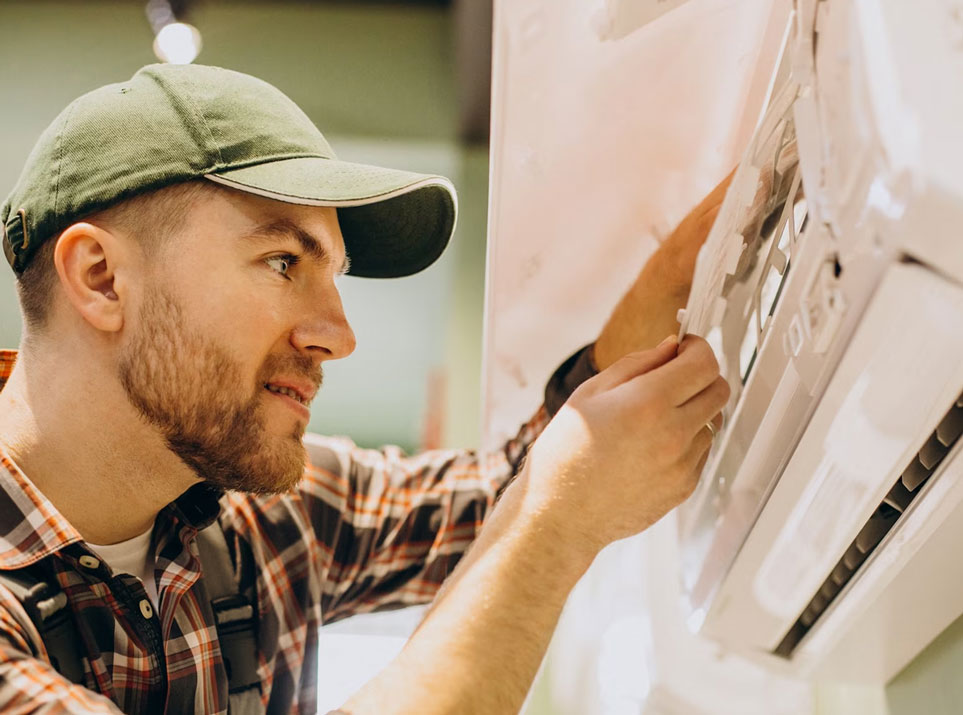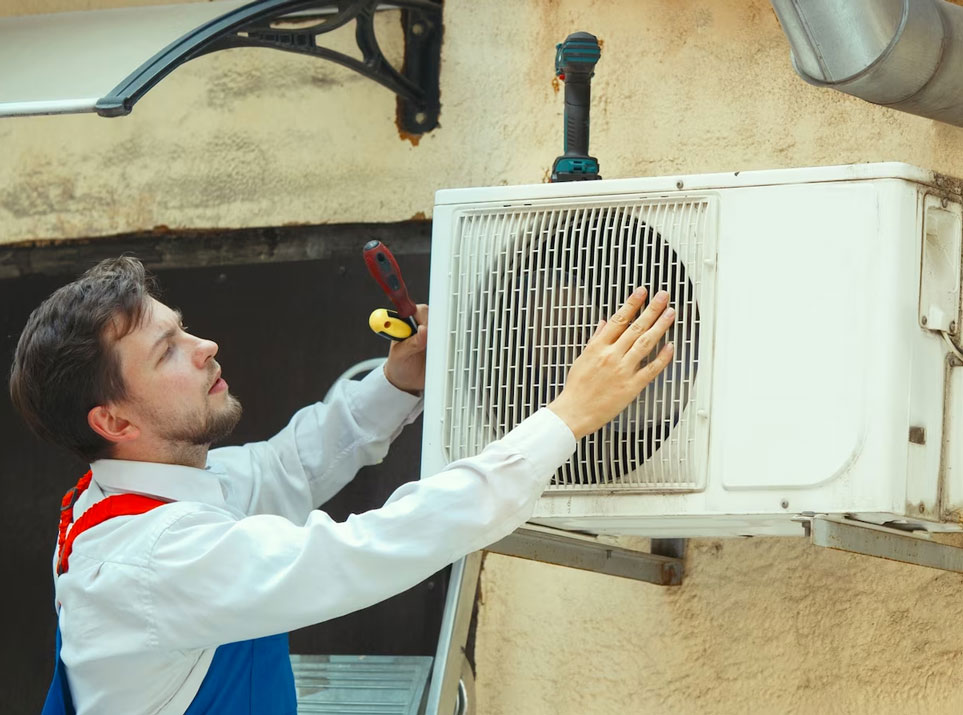Why AC Not Cooling Below 75? The temperature of the air conditioning system is a vital aspect that determines the comfort level in a room. However, it can be frustrating when your AC unit fails to cool below 75 degrees, especially during hot summer months. There could be several reasons why your AC isn’t cooling effectively, and identifying the cause is essential for resolving the issue.
In this blog, we’ll talk about some of the most common causes for an AC not cooling efficiently. Plus, we’ll give you helpful tips to get it working again. Let’s get started and solve your air conditioning issues!
Reasons Why AC not cooling below 75

Your air conditioner not cooling below 75 degrees Fahrenheit could have many explanations. Fix it before it gets worse and bills go up!
1. Thermostat Settings Causing AC not cooling below 75
If your air conditioner won’t cool below 75 degrees, the thermostat could be the culprit. Thermostats control your home’s temperature, but an old or broken one may not work correctly.
Here are some steps to check and adjust the thermostat:
- Make sure it’s set correctly. Ensure the setting corresponds with what your AC should do. And, turn it up enough so it won’t cycle off before reaching the desired temp.
- Check the sensitivity. If it’s too high, it may take time for the temp to reach a certain point. See if you can make any changes to increase sensitivity.
- Check airflow. All vents and ducts should be open, clear and providing adequate airflow throughout your home. This will ensure optimal performance from your AC.
- Examine wiring. Check connections between the AC and thermostat if you think electrical issues are occurring. If needed, call a HVAC technician for help with any faulty wiring or electrical problems.
2. Dirty Air Filter
A filthy air filter can stop an air conditioner from cooling a room under 75 degrees Fahrenheit. Over time, the filter gets filled with dust, pet hair, and other dirt.
This limits the flow of cold air through the AC, making it hard to achieve the wanted warmth. It’s critical to frequently look at your air filter and replace it when needed. This helps your AC system to function well.
3. Refrigerant Levels
Refrigerant, usually a gas or liquid, carries heat around an air conditioning system. Not enough refrigerant can stop an AC from cooling properly – temperatures won’t go below 75.
Low refrigerant levels have three possible causes: Leaks, inadequate installation, or poor maintenance.
If you think your AC isn’t cooling properly, a technician should check for leaks. If no leaks are found, inadequate installation may be the cause. Parts may need to be installed to fix this.
4. Dirty Condenser Coils
These coils release the hot air from inside the house. As it passes through, the air is cooled and pushed back into the house to keep it comfy.
But, if the coils get clogged, they can’t cool the air properly. This means the AC won’t produce enough cool air.
5. Faulty Compressor
If your air conditioner is not cooling below 75 degrees, then there might be a problem with the compressor. The compressor is the heart of an air conditioning unit that compresses and circulates refrigerant to cool down the indoor environment. A faulty compressor can result in inefficient cooling or no cooling at all.
The most common sign of a faulty compressor is warm air blowing from the AC vents. This means that the compressor is not working properly, and it cannot circulate enough refrigerant to cool down your home. Other symptoms may include strange noises coming from the outdoor unit, increased energy bills, and frequent system breakdowns.
Fixing AC Not Cooling Below 75

If your air conditioner is not cooling below 75 degrees Fahrenheit, it could have several causes. Troubleshooting can be tough, so a pro HVAC technician may be the way to go. To solve the problem temporarily you can try using ceiling fan alternatives for low ceilings. If you choose to try it yourself, Here are a few tips.
1. Check the air filter
A dirty filter restricts airflow, making it difficult for cool air to circulate throughout your home.
To check your air filter, simply locate the return vent on your AC unit and remove the cover. Your air filter should be visible and easily accessible inside. If you notice that it appears dirty or clogged with dust and debris, it’s time to replace it with a new one.
Replacing an old or dirty air filter can make a significant difference in the efficiency and effectiveness of your AC system.
2. Clean the outdoor unit
The first step in cleaning the outdoor unit is turning off power to both the indoor and outdoor components of your AC system. This will prevent any electrical accidents while you clean. Next, remove any large debris from around or inside the unit.
Then, use a garden hose to gently spray water onto the coils and fins at an angle to avoid bending them. If there’s stubborn buildup that doesn’t come off with water alone, use a soft brush or vacuum attachment to carefully remove it.
3. Check the thermostat
To check the thermostat, start by making sure it’s set to “cool” mode and that the temperature setting is below 75 degrees. If it’s still not cooling properly, try changing the batteries in your thermostat to see if that fixes the issue.
If that doesn’t work, take off the cover of your thermostat and clean any debris or dust buildup inside. Dust can interfere with its sensors and cause inaccurate readings.
4. Check the refrigerant level
Refrigerant is the key component that absorbs heat from inside your home and transfers it outside. It’s essential to have a proper refrigerant level in your AC unit as it affects its overall performance.
A low refrigerant level can cause several issues with an air conditioning system, including reduced cooling capacity, compressor failure, increased energy bills, and even complete system failure over time.
The good news is that fixing an AC not cooling below 75 because of low refrigerant levels is a relatively simple process. All you need to do is call a professional HVAC technician who can check and refill the refrigerant levels in your AC unit to ensure optimal performance and efficiency.
5. Check for leaks
Air conditioning systems work by circulating refrigerant through a closed loop circuit, and any leaks in the circuit can cause the refrigerant to escape, reducing the efficiency of the system. This leads to warmer air being blown into your home instead of cool and refreshing air.
The first step in diagnosing this issue is to check for leaks in your AC system. Leaks can occur at various points such as around fittings, connections or valves. These are common areas that tend to wear out over time due to constant use or age-related deterioration.
It’s important to note that fixing leaks requires professional help from an experienced technician with specialized equipment. You also have to ensure there is no leak on your room, check on how to fix hole in wood door.
6. Check the ductwork
The ductwork plays a crucial role in distributing cool air throughout your home, but if there’s a blockage, it can cause restricted airflow.
One way to ensure that your AC is working efficiently is by regularly checking the ductwork for any signs of damage or debris buildup. Over time, dust, dirt, and other contaminants can accumulate in the air ducts which not only hinders airflow but also affects indoor air quality. This results in reduced comfort levels and higher energy bills due to increased strain on the system. Check also Kenmore Refrigerator Not Cooling.
Why My AC temperature is not going down?
The issue could be due to clogged air filters, dirty fan blades, incorrect thermostat settings, inadequate insulation, cooling coils, frozen evaporator coils, or low refrigerant levels. The professional will have the right tools to check each component and identify the problem.
Sometimes, simple maintenance is enough, e.g. cleaning a clogged filter or replacing a broken fan blade. If major repairs are needed, such as bleeding off trapped refrigerant, it’s best to hire an experienced expert. Don’t wait if you’re having trouble cooling below 75 degrees with your AC unit – call in a professional!
Thermostat set at 72 but reads 75
Is your thermostat set to 72 degrees Fahrenheit, yet your air conditioner isn’t cooling below 75 degrees? It’s essential to find the cause. The most common reason is an inadequate air flow. It may be from a blocked vent, clogged filter, or dirty condenser coil. It could also be due to an improperly sized AC system when first installed.
To check, measure the air flow in each room and compare with BTU output. Lastly, a faulty thermostat could be the reason. Inspect annually and replace every three-five years to keep it maintained. If recently replaced, it may need calibrating or reprogramming.
How to Fix AC not Cooling During The Day?
Hot outdoor temps can stop your AC from cooling below 75°. Your AC has to work harder and use more energy to lower indoor temps. ACs rely on the difference between indoor and outdoor temps. To increase efficiency, do regular maintenance like changing air filters and scheduling inspections.
Keep windows and doors that open outside shut. Curtains should be closed to reduce direct sunlight which warms up a room quickly. Invest in a programmable thermostat to adjust AC settings based on time and pref.
AC not turning on at set temperature
If your air conditioning system won’t turn on at the temperature it’s set to, there are a few potential causes.
First, check the air filter. If it’s clogged with particles, it can block airflow and reduce AC efficiency. Change the filter every 1-3 months for optimal functioning.
Next, check any fuses and circuit breakers related to your AC. If they’re bad or switched off, that could be why it’s not turning on. Changing or resetting them may help.
Thirdly, inspect any heating elements, like transformers and capacitors. If they’re faulty, your AC won’t cool correctly at the desired temperature. To fix this, you may need to replace the components. But always follow safety instructions when dealing with electrical components.
Finally, if all else fails, your thermostat could be the issue. It controls how often your AC turns on and off. If it’s broken, it may overheat instead of cooling. You may need professional help to diagnose and repair it.
Should I turn off AC if it’s not cooling?
No! You should not turn off AC if its not cooling. If your air conditioner isn’t cooling properly, you should try troubleshooting it before switching it off. Remember, switching it off is a last resort.
Check the filters and components of the HVAC system, like the air filters, fans, grilles, and vents, to make sure they’re clean and unobstructed. Adjust the thermostat setting if it’s set too low. In humid climates, saturated AC coils can cause cooling problems. If this happens, get a professional technician to service the system.
Make sure all windows are closed when running the AC so warm outdoor air doesn’t enter. If you can’t take other steps before turning off the AC, ask an HVAC expert for advice. Maintenance needs, weather conditions, and comfort all need to be taken into account.
“There is no real ending. It’s just the place where you stop the story.”






